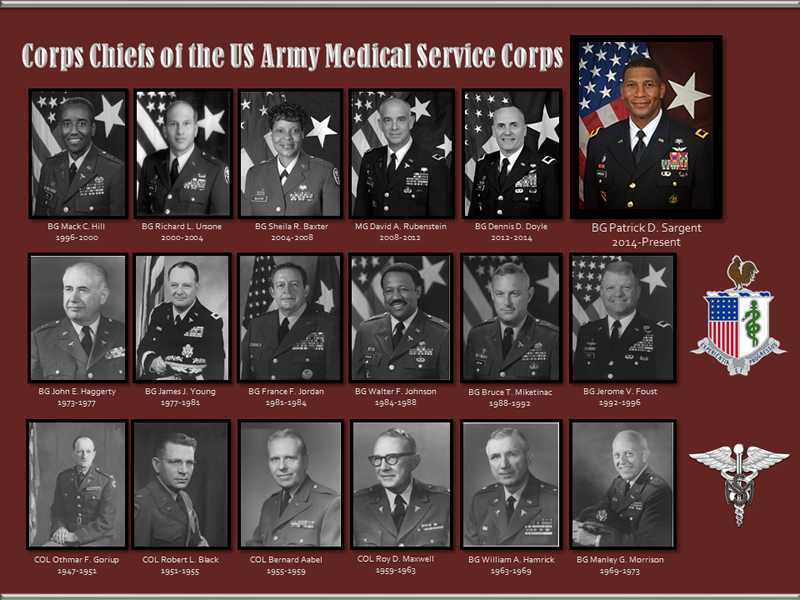
Text version of MSC Corps Chiefs chart.
 The History of the U.S. Army Medical Service Corps
The History of the U.S. Army Medical Service Corps
by Richard Van Ness Ginn, COL (Ret.) is an obvious milestone.
The United States Army Medical Service Corps is an important national resource with a long and distinguished history. Many thousands of officers have proudly served in its ranks, selflessly supporting the nation's defense missions in peace and war throughout the world. With varied academic backgrounds and disciplines, these officers have been widely recognized and highly regarded leaders in their respective fields. They represent the growth in medical science and military medical operations and administration over two centuries.
The story of the U.S. Army Medical Service Corps is evolutionary. Precursors such as Revolutionary War apothecaries and officers of the Civil War Ambulance Corps evolved into the World War I Sanitary Corps which was established on June 30, 1917, as a temporary part of the Medical Department based on authority provided by an 18 May 1917 Act of Congress. This corps, which rapidly expanded to nearly 3,000 officers during the War, enabled the relief of physicians from a variety of administrative, technical and scientific duties. The Sanitary Corps was demobilized following the war.
During the inter-war years, it became clear that the Army needed a permanent medical ancillary organization. This led to the establishment of the Medical Administrative Corps (MAC) on 4 June 1920. Growth in WW II was spectacular. The MAC increased from less than 100 officers in 1939 to over 22,000 by 1945. These officers freed physicians for patient care responsibilities by occupying an expanded variety of positions. These positions included replacement of the second physician in maneuver battalions.
A third precursor, the Pharmacy Corps, was established as a Regular Army branch on 12 July 1943. Finally on 4 August 1947, the Sanitary, Administrative and Pharmacy Corps were replaced by the Medical Service Corps consisting of four sections: Pharmacy, Supply and Administration, Medical Allied Sciences, Sanitary Engineering, and Optometry.
MSC Medical Battalion commanders in Korea remained in command as those units performed their combat missions upon the outbreak of hostilities in 1950. MSC aviators were assigned to the first helicopter evacuation detachments in Korea, units that presaged the revolutionary role of the helicopter ambulance. These MSC officers and their crews wrote a glorious chapter in Vietnam with the receipt of every award of valor including the Medal of Honor.
Individual MSCs have figured prominently in Army Medical Department scientific achievements. A few examples:
-
Major Reuben L. Kahn, SNC, developed a procedure that became the serological test for syphilis (1918).
-
Colonel George W. Hunter, III, MSC, developed a snail poisoning program which essentially eliminated schistosomiasis in Japan. (1950-53).
-
Lieutenant Colonels Dan C. Cavanaugh and John D. Marshall, MSC, made significant advances in the understanding of plague through the linking of plague epidemics to weather, developing serological tests and documenting the efficacy of the vaccine (1960-70).
-
Colonel Frank R. Camp, MSC, led the Army programs in blood banking and transfusion research to a world-wide influence (1964-75).
-
Colonel Robert B. Lindberg, MSC, and colleagues developed sulfamylon cream which markedly reduced burn mortality (1965).
-
Lieutenant Colonel Charles R. Angel, MSC, and a team of researchers provided the technology transfer which enabled the establishment of the first mass screening laboratory for heroin testing in large populations (1971).
-
Captain Millie Hughes-Fulford, MSC, USAR, was selected in 1984 as an astronaut for the Spacelab IV mission, becoming the first astronaut of any medical department.
Today, MSCs provide the administration, planning, programming and budgeting of every Army Medical Department effort. They maintain the Army's wartime medical capability through command of its field medical establishment. They operate what may be the most effective logistical system anywhere. In countless ways, the men and women of the Medical Service Corps are at the forefront of the Army Medical Department's humanitarian role in national defense.
The History of the U.S. Army Medical Service Corps

